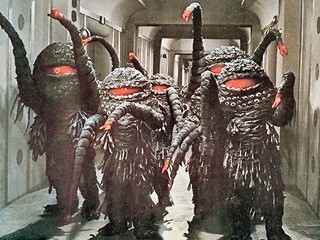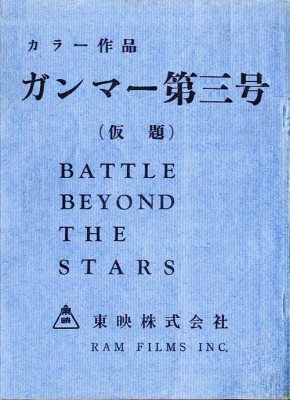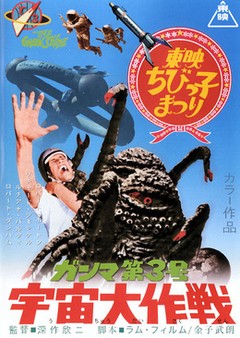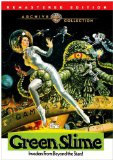| Reviews & Columns |
|
Reviews DVD TV on DVD Blu-ray 4K UHD International DVDs In Theaters Reviews by Studio Video Games Features Collector Series DVDs Easter Egg Database Interviews DVD Talk Radio Feature Articles Columns Anime Talk DVD Savant Horror DVDs The M.O.D. Squad Art House HD Talk Silent DVD
|
DVD Talk Forum |
|
|
| Resources |
|
DVD Price Search Customer Service #'s RCE Info Links |
|
Columns
|
|
|
Green Slime (Warner Bros. Archive Collection), The
But now comes The Green Slime in all its goofy glory, courtesy the Warner Bros. Archive Collection. Though a DVD-R its 16:9 enhanced widescreen transfer of this Toeiscope production generally looks quite nice. In fact, as far as I know it's the first time the film has been available in widescreen at all in the U.S. since its theatrical release.
Japanese ad art, with the original shooting script at center
When a runaway asteroid - which resembles a colossal molding cantaloupe - threatens earth, retired astronaut Jack Rankin (Robert Horton) is ordered to take command of Space Station Gamma 3. At the expansive outpost (not unlike sets from the reimagined Battlestar Galactica), populated by a large contingent of soldiers and medical personnel, Rankin runs into old girlfriend Lisa (Luciana Paluzzi) and her fiancé, Commander Vince Elliot (Richard Jaeckel), formerly Rankin's best friend. In a first act identical to the climax of the later Armageddon, Rankin, Elliot and some men hurriedly launch a rocketship toward the asteroid, laying charges there to blow it up before it reaches earth. The mission is a success, but a green, globby liquid is brought back to the station unnoticed, and, rising from the soapy green suds little creatures grow and spread like a virus, creating hoards of clumsy but electrified and tentacled monsters!
Produced by Americans but filmed in Japan with a mostly Japanese crew - including its director, Kinji Fukasaku - with a supporting cast of local expatriates and extras drawn from a nearby U.S. Air Force base, The Green Slime has two big strikes working against it. For a relatively low-budget sci-fi thriller Made in Japan it's actually reasonably good until the monsters show up, at which point all credibility goes sailing out the airlock. I suspect the filmmakers were influenced by the Japanese film The H-Man (Bijo to ekitainingen, 1958), about slimy goop-like creatures that, like The Blob (also 1958), absorbed its victims. The H-Man's special effects were directed by Eiji Tsuburaya and The Green Slime is the work of his disciples, including Akira Watanabe. There are several H-Man-type shots of green slime oozing up walls and the like, and a scene almost identical to one in The H-Man where the slime is electrocuted in a Petrie dish. Perhaps, like The H-Man, the initial idea was to limit the roly-poly monsters to just a few scenes and to keep them hidden in the shadows.
Instead, the audience sees way too much of the ludicrous critters, which look more like a cross between midget mutant octopi and wayward cast members from Lidsville, the Sid & Marty Krofft series set in a land of anthropomorphic hats. They waddle through scenes like unsteady treat-or-treaters, and make comical squeaking noises when they attack. The film is over-lit, so much so that when the power goes out throughout the station there's hardly any difference.
The other big problem with the film is its overwrought, horribly clichéd love triangle and leadership dynamic, lifted from a hundred other military-type pictures. Rankin is the harsh, uncompromising leader: implacable, unemotional bordering on cruel, while Elliot is more expressive, humanist but less confident, who once made the mistake of "sacrificing ten men to save one." Lisa, meanwhile, is caught in the middle, engaged to Elliot but really in love with Rankin, though she won't admit it. In these stories sometimes the imperfect, humanist one comes out on top but in this case it's the hard-nosed leader all the way. He makes all the right choices; absolutely everything Elliot tries ends in total disaster. (And it's the kind of part Jaeckel had been playing as far back as Battleground, in 1949.) It's clichéd in the extreme and so devoid of any shading that all this testosterone-driven footage is both hysterical and boring at the same time. The film leans so heavily on war movie clichés there's even a scene where Elliot's rifle jams - his laser rifle - and, in desperation, he tosses it at one of the creatures. Rankin does the very same thing a few minutes later.
On the other hand, The Green Slime usually doesn't get any credit where credit is due. Before the stupid-looking monsters show up, particularly all the business about the runaway asteroid, the film is actually cheap but effective, tautly edited and generates a fair amount of excitement. The special effects are variable and the budget precluded anything on the scale of, say, 2001: A Space Odyssey, MGM's other big outer space adventure of the late-1960s, but while never photo-realistic the miniature effects show a lot of imagination and flair. And like the live-action scenes they are edited in such a way to generate excitement, if not realism. Overall, it's light years ahead of the dreary Wild, Wild Planet (1965) and The War of the Planets (1966), Italian-made spectacles made by one of The Green Slime's production companies, and of which this is unofficially part of the same series.
Horton, Jaeckel, and Italian-born Paluzzi, all veteran actors, appear with semi-professional types like co-producer William Ross, who plays Ferguson, and Robert Dunham, as Elliot's second-in-command, Captain Martin. Ross owned (and at last report, at the age of 88 still owns) a Tokyo-based company that dubs Japanese movies into English and coordinates the production of western world productions filmed in Japan. Dunham, who frequently worked for Ross, spoke excellent Japanese which helped him land sizable roles in domestic productions, including director Kinji Fukasaku's fourth feature film, High Noon for Gangsters (also known as Greed in Broad Daylight, Hakuchu no buraikan, 1961), though he's best-known for kaiju eiga like Dogora the Space Monster (1964) and Godzilla vs. Megalon (1973).
Near as I can tell, dialogue was recorded live though in this case as much as 80% was re-looped for its American release. (The entire film was dubbed into Japanese for release there.) While Horton, Jaeckel, and Paluzzi's voices are heard throughout, in some scenes Ross's and Dunham's actual voices are heard but in other scenes their dialogue may be dubbed by someone else. Most everyone else was clearly dubbed during postproduction by other performers. At least two ingénues from earlier Japanese films turn up: Kathy Horan, best known for her juicy part as a war widow in Goke, Bodysnatcher from Hell (1968), and Linda Miller, the petite and badly-dubbed heroine of King Kong Escapes (1967). Both play nurses and have little-to-no dialogue but are onscreen a lot.
The Japanese version of The Green Slime differs from the American one in at least two respects, both improvements. The U.S. version ran 90 minutes, but Fukasaku's cut clocks in at a brisk 77 minutes, some 13 minutes shorter. Fukasaku seems to have mainly trimmed the labored and clichéd conflict between Rankin and Elliot, and the result is a film of almost non-stop action. He told me in a 1996 interview that he regarded the conflict between the accident-prone, in-over-their-heads soldiers and unstoppable, innumerable adversaries as a metaphor for the U.S. involvement in Vietnam (!) but nothing in the picture specifically points to this. The first act race to blow-up the asteroid has real energy in both versions, but afterwards the U.S. cut gets sluggish while Fukasaku's version retains the same pace for the rest of the picture.
And yet for all of Fukasaku's skill and ambitions, The Green Slime's fate in Japan was, arguably, even worse than its campily promoted American release. In Japan it went out as part of a package of features and shorts called Toei chibi-ko matsuri ("Toei Little Children's Festival"), topping a bill that included the animated Pinocchio in Outer Space.
Charles Fox re-scored much of the film for its release in America, most notoriously adding a lively but wildly inappropriate title song. The Japanese score, by Toshiaki Tsushima, is a mélange of pounding military marches and the like, and better suited to the material.
Video & Audio
Both this and Toei Video's DVD of The Green Slime are 16:9 enhanced widescreen format, preserving the original Toeiscope (2.35:1) original aspect ratio. The color is better on the Warner Archive release, though the U.S. DVD exhibits more damage and, debatably, very slightly less detail. The Dolby Digital mono is adequate, though hard-of-hearing fans may be out of luck: the disc is neither subtitled nor closed-captioned.
Extra Features
Though the Japanese disc was fairly crammed with supplements, this has none, not even a trailer.
Parting Thoughts
Supremely goofy but action-packed and crammed with sci-fi hardware and imagination throughout, The Green Slime is perfect Saturday matinee fun. Recommended.
Kyoto-based film historian Stuart Galbraith IV's latest book, Japanese Cinema, is on sale now.
|
| Popular Reviews |
| Sponsored Links |
|
|
| Sponsored Links |
|
|
| Release List | Reviews | Shop | Newsletter | Forum | DVD Giveaways | Blu-Ray | Advertise |
|
Copyright 2024 DVDTalk.com All Rights Reserved. Legal Info, Privacy Policy, Terms of Use,
Manage Preferences,
Your Privacy Choices | |||||||















